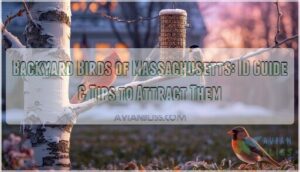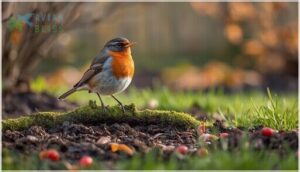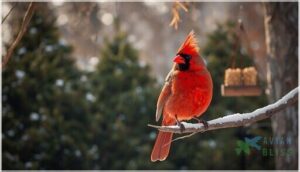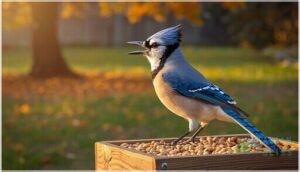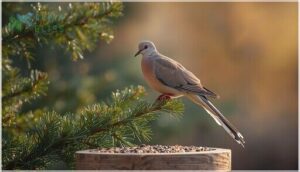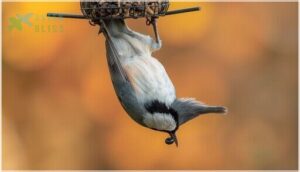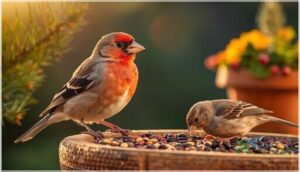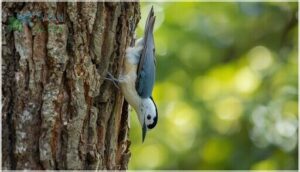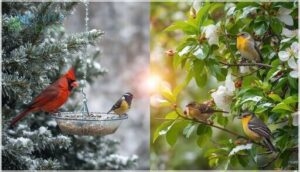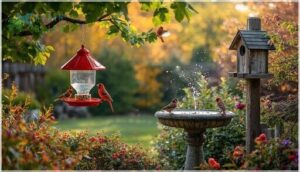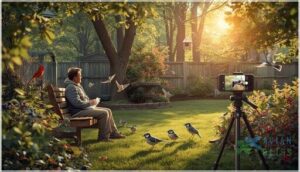This site is supported by our readers. We may earn a commission, at no cost to you, if you purchase through links.
Your backyard isn’t just a patch of grass. It’s a rest stop on an ancient migration route. Every spring and fall, millions of birds pass through Massachusetts. Some stay all year, while others drop in for a season.
The American Robin population has dropped by a third in fifty years. That makes every backyard more important than ever. When you know what to look for, you’ll spot the Black-capped Chickadee flitting through branches. You’ll recognize the Northern Cardinal’s bright red feathers against winter snow.
Learning to identify these visitors transforms your morning coffee into a front-row wildlife show. You’ll also discover simple ways to make your yard a haven for the species that need it most.
Table Of Contents
- Key Takeaways
- Common Backyard Birds in Massachusetts
- Identifying Backyard Bird Species
- Seasonal Bird Visitors and Migration
- Attracting Birds to Your Backyard
- Birdwatching Tips and Conservation Efforts
- Frequently Asked Questions (FAQs)
- How do I identify a bird in my backyard?
- What are the most common birds in Massachusetts?
- Is it good to have birds in your yard?
- What are the most common winter birds in Massachusetts?
- What are the benefits of bird watching?
- How do birds impact local ecosystems?
- What diseases can backyard birds carry?
- Are there any bird watching clubs in Massachusetts?
- How do city landscapes affect bird populations?
- What predators threaten backyard birds in Massachusetts?
- Conclusion
Key Takeaways
- Massachusetts backyards sit on ancient migration routes where bird populations like the American Robin have dropped by a third in fifty years, making every backyard habitat increasingly critical for species survival.
- You can identify birds by noting size and shape first, then watching for color patterns, bill type, behavior, and songs—tools like Merlin app achieve over 90% accuracy when combined with traditional field guides.
- Simple changes like offering native plants, clean water sources, and pesticide-free zones transform your yard into a haven while feeders need cleaning every two weeks to prevent disease spread among visiting flocks.
- Your backyard observations through citizen science programs like eBird contribute real conservation data that helps scientists track population changes and protect declining species across the state.
Common Backyard Birds in Massachusetts
You’ll spot a great mix of birds in your Massachusetts backyard throughout the year. Some are here every season while others visit during specific times.
Here are nine common species you’re likely to see and hear around your home.
Black-capped Chickadee (State Bird)
You’ll spot the Black-capped Chickadee year-round in Massachusetts backyards. This lively state bird measures about 5 inches long with white cheeks and a black cap. It became the official state bird in 1981.
- Lives around 2 years in the wild
- Nests in tree cavities starting mid-April
- Forages mainly by gleaning seeds and insects from bark
- Visits bird feeders frequently during winter months
The Black-capped Chickadee plays an important role in state bird conservation.
American Robin
Another common Massachusetts backyard bird is the American Robin. You’ll recognize this species by its orange-red breast and gray-brown back. The robin population in Massachusetts faces challenges, with numbers declining about one-third over fifty years.
Their feeding habits focus on earthworms and berries. Migration timing has shifted earlier due to climate change. Nesting behavior includes raising multiple broods each season.
Despite regional declines, population stability remains moderate across North America. The American Robin’s migration patterns are influenced by facultative migration strategies.
Northern Cardinal
The Northern Cardinal stands out with vivid red plumage that makes bird identification easy. Males defend their backyard territory year-round since this species doesn’t migrate. You’ll attract cardinals with sunflower seeds at bird feeders.
Their nesting behavior involves raising two to three broods annually in dense shrubs.
The cardinal population has grown considerably in Massachusetts since 1960. Conservation status remains stable across the state.
Blue Jay
Blue Jays bring bold color and loud personality to Massachusetts backyard birds. You’ll recognize them by their striking blue feathers and noisy jay vocalizations. These birds show feeder dominance at sunflower seed stations. They help forests grow through acorn dispersal when caching food. Here’s what makes them interesting:
- Population trends show quiet declines in recent years
- Nesting success reaches about 40% in Massachusetts
- They mimic hawk calls to warn others
- Males feed females during breeding season
- Spring migration peaks between March and May
Blue Jays stay year-round but some migrate locally.
House Sparrow
House Sparrows thrive in Massachusetts cities and suburbs where people live. You’ll find these backyard birds at feeders with stocky brown bodies and black bibs. Their nesting habits include building messy grass nests in building crevices.
Population decline affects Massachusetts, but they remain common. Their dietary flexibility lets them eat seeds and insects.
Conservation status shows widespread urban adaptation despite recent drops in numbers across bird identification surveys.
Mourning Dove
Mourning Doves bring a peaceful presence to your Massachusetts yard with their soft cooing calls. You’ll spot these backyard birds by their brownish-gray bodies and long pointed tails with white edges.
They love feeding on seeds at bird feeders and on the ground. Their populations have tripled since the 1950s thanks to better protection.
These gentle visitors prefer nesting in evergreens and raise multiple broods each season.
Tufted Titmouse
You’ll recognize the Tufted Titmouse by its gray crest and curious personality at your feeders. Watch its foraging habits as it hangs upside down grabbing sunflower seeds.
This backyard bird has enjoyed considerable range expansion across Massachusetts since 1959. The species now thrives in 92% of surveyed areas. Its conservation status remains stable with population trends showing steady increases statewide.
House Finch
You’ll spot male House Finches at bird feeders by their rosy-red plumage brightness across the chest and head. Females wear brown streaks that help with backyard birding identification.
These backyard birds eat mostly seeds but also berries and buds. Watch for their nesting habits in evergreens or potted plants.
Disease impact from conjunctivitis has caused population trends to fluctuate since the 1990s despite their diet variation adaptability.
White-breasted Nuthatch
White-breasted Nuthatches walk headfirst down tree trunks in your Massachusetts backyard. You’ll identify them by their blue-gray backs and white faces.
Their diet composition shifts from 100% insects in summer to 68% seeds in winter.
These backyard birds nest in cavities from 10 to 50 feet high.
Conservation status shows habitat expansion with breeding behavior documented in 962 survey blocks statewide.
Identifying Backyard Bird Species
You don’t need to be an expert to identify the birds visiting your yard. A few simple clues can help you tell one species from another.
Here’s what to look for when you spot a new feathered visitor.
Size, Shape, and Silhouette
When you’re trying to figure out which backyard birds visit your yard, size and shape matter more than you might think. Bird identification starts with these basics before you even worry about color.
Here’s what to watch for:
- Black-capped Chickadees show a tiny rounded body about 5 inches long with a big head
- American Robins stand upright at 10 inches with a plump build and long legs
- Blue Jays reach 12 inches with bold crests and tapered tails
Flight patterns reveal silhouette identification clues too. Shape variation helps separate similar bird species fast.
Color Patterns and Plumage
Color patterns offer the clearest bird identification clues once you’ve noted size and shape. Sexual dimorphism like this helps separate species fast. Male Northern Cardinals display vivid red plumage while females show tan with red accents. American Robins reveal darker heads and richer orange breasts in males.
Seasonal changes matter too since American Goldfinches shift to bright yellow during breeding season while juvenile plumage appears duller until birds mature.
Bill Type and Color
Beyond plumage and patterns, bills tell you what birds eat and who they’re. Northern Cardinals flash bright orange-red bills built for cracking seeds. Black-capped Chickadees have short black bills perfect for gleaning insects. Blue Jays sport sturdy multi-purpose bills around 18-20 mm long.
Bill morphology reveals feeding adaptations that help you identify backyard birds fast using bird feeders as your classroom.
Behavior and Flocking Patterns
How birds behave reveals their identity just as bills do. Black-capped Chickadees form small winter flocks of 2-10 individuals with social hierarchy. American Tree Sparrows flock at feeders and use constant two-note calls for flock communication. Common Grackles show aggressive dominance while Blue Jays cooperate in loose groups.
Watch their roosting habits and foraging strategies for quick Massachusetts bird identification and predator avoidance clues.
Songs and Calls
Listening closely teaches you what watching reveals. Bird songs help identify species through distinct vocal patterns. Bird vocalizations differ by species:
- Black-capped Chickadees produce their “chickadee-dee-dee” call and a clear “fee-bee” song frequency around 400 Hz.
- Northern Cardinals engage in duet singing with whistles traveling a quarter-mile.
- Blue Jays show vocal learning through mimicry of hawk calls.
Call variations increase during the breeding season.
Using Field Guides and Apps
You’ll find modern tools like Merlin and eBird transform bird identification techniques into instant results. Apps achieve over 90% identification accuracy for common species through photos and sounds. Traditional bird identification guides excel with offline use and rare species details. Massachusetts birders increasingly blend both methods. Digital integration with QR codes bridges expert ornithology with beginner accessibility. Try combining field guides with apps for confident bird watching outcomes.
| Tool Type | Best For |
|---|---|
| Field Guides | Offline use and rare species |
| Apps (Merlin/eBird) | Real-time ID and citizen science |
| Combined Approach | Maximum accuracy and learning |
Seasonal Bird Visitors and Migration
Massachusetts bird activity changes with the seasons. Some species stick around all year while others show up for just a few months.
Understanding these patterns helps you know which birds to expect and when to look for them.
Year-round Resident Birds
Some birds stick around all year in Massachusetts. The Black-capped Chickadee and American Robin show strong population stability. Northern Cardinals and Mourning Doves are also common backyard birds you’ll see every season.
These species thrive because they adapt well to local habitat preferences. They find food year-round and adjust their dietary needs as seasons change. You don’t need luck to spot them.
Winter Visitors (e.g., Dark-eyed Junco)
When cold settles in, Dark-eyed Juncos arrive from the north. You’ll spot them hopping under feeders looking for seeds on the ground. Their slate-gray backs and white bellies make Junco identification easy.
These winter backyard birds prefer wooded edges and suburban yards. House Sparrows and White-throated Sparrows join them. Their migration patterns and feeding strategies help them thrive in Massachusetts winters.
Spring and Summer Migrants
When spring arrives, your yard transforms into a migration highway for birds traveling north. Migration timing peaks around mid-May when over 50% of all migrants pass through Massachusetts in just 12 days.
Watch for these spring and summer birds:
- Ruby-throated Hummingbird – buzzing at your flowers
- Indigo Bunting – vivid blue males singing
- Black-throated Blue Warbler – warbler identification made easier with striking colors
- Osprey – raptor migration brings these fish hunters
- Bobolink – bubbling songs in grasslands
These backyard birds connect Massachusetts to habitat connections across Central and South America. Summer birds face population decline challenges, making your observations valuable for conservation.
Fall Migration Patterns
Fall migration patterns transform Massachusetts into a highway for backyard birds heading south. Nocturnal migration peaks between September and November when over 1.3 million birds pass through in a single night.
Environmental factors like clear skies and north winds at 10-25 mph trigger massive movements.
Monitoring migration through BirdCast helps you track species identification and migration routes in real-time.
Effects of Climate Change on Migration
Climate change is reshaping migration patterns right in your backyard. Migration timing shifts mean birds arrive 0.11 days earlier each year on average. These changes affect migratory bird behavior throughout Massachusetts.
Phenological mismatches between food availability and arrival threaten 66% of long-distance migrants. Range expansion brings southern species north, while others face habitat loss impacts and survival rate decline.
Climate change threatens two-thirds of long-distance migrants with mistimed arrivals while pushing southern species northward and endangering others through habitat loss
Attracting Birds to Your Backyard
Turning your yard into a bird haven is easier than you might think. The key is offering what birds need most: food, water, shelter, and a safe place to raise their young.
Let’s look at five simple ways to make your Massachusetts backyard irresistible to birds.
Providing Bird Feeders and Food Types
Setting up bird feeders transforms your yard into a gathering spot for feathered neighbors. Different feeder types attract different species. Tube feeders work well for chickadees and finches. Platform feeders bring in cardinals and robins. Suet feeders are perfect for woodpeckers.
Consider these bird feeding strategies:
- Black oil sunflower seeds attract the widest variety of species
- Nyjer seeds bring goldfinches to your tube feeders
- Suet cakes provide high-energy winter fuel for woodpeckers
- Fresh mealworms attract robins and bluebirds year-round
- Clean feeders every two weeks to prevent disease spread
Seasonal feeding matters too. Winter brings more visitors as natural food disappears. Spring migrants need protein-rich options like mealworms. Stock hummingbird feeders from late spring through early fall. Vary your offerings throughout the year to support different nutritional needs.
Feeder hygiene protects your backyard birds. Wash feeders with diluted bleach solution monthly. Space multiple feeders apart to reduce crowding. Remove spilled seeds beneath feeders to keep feeding areas clean.
Your bird feeder preferences shape which species visit. Ground feeders attract towhees and sparrows. Hanging feeders work for acrobatic chickadees. The feeding impact goes beyond entertainment. You’re supporting bird survival during harsh Massachusetts winters.
Offering Water Sources and Bird Baths
Feeders bring birds to your yard, but water keeps them coming back. Birds need water for drinking and bathing year-round. A simple birdbath attracts more species than feeders alone.
Here’s what works for Massachusetts birds:
| Feature | What You Need |
|---|---|
| Depth Considerations | Keep water 1-2 inches deep with gradual slopes |
| Cleaning Frequency | Scrub with diluted vinegar weekly to prevent disease |
| Location Placement | Choose partly shaded spots near shelter but visible to you |
Bath Material Safety matters too. Stone and ceramic options handle our freeze-thaw cycles better than plastic. Winter Water Solutions like heated birdbaths prevent ice during cold months when natural sources freeze solid.
Change water every few days in summer heat. Clean surfaces stop disease spread among visiting flocks. Position your bath where cats can’t ambush drinking birds.
Attracting birds backyard becomes easier with reliable water. Bird baths complement bird feeders by meeting different needs. You’ll spot warblers and thrushes that ignore seed offerings. Even backyard birds in Massachusetts that don’t eat seeds still need to drink and bathe.
Your water feature works hardest during migration and winter. Spring and fall travelers depend on stopover hydration. Cold weather residents struggle when ponds freeze over.
Planting Native Trees and Shrubs
If you want more backyard birds in Massachusetts, start with native plants for birds. Native plant benefits go beyond looks—they offer seeds, berries, and insects for bird habitat design. Gardening for birds means choosing white oak, highbush blueberry, and winterberry holly.
Removing invasive species helps stop shrubland bird decline. Winter food sources like red chokeberry keep birds visiting your backyard bird habitats.
Creating Shelter and Nesting Sites
Native plants attract birds, but shelter keeps them around. Natural cover like dense evergreens and brush piles offers protection from predators and weather. Nest boxes boost breeding success for cavity nesters in Massachusetts.
Here’s what works:
- Install boxes for Bluebirds and Tree Swallows by early April
- Add roosting boxes for winter warmth
- Leave dead branches for woodpeckers
Your backyard habitat encourages nesting behavior when artificial shelters fill gaps in nesting sites.
Avoiding Pesticides and Maintaining Habitat
Beyond shelter and food, pesticides threaten bird reproduction and survival in Massachusetts. Thousands of backyard birds face harm from common yard chemicals each year. Chemical consequences include smaller chicks and breeding failures.
You can switch to safer alternatives like manual weeding and native plants that naturally deter pests. Safe maintenance protects habitat while supporting bird conservation. Choose pesticide-free zones to sustain healthy populations.
Birdwatching Tips and Conservation Efforts
Watching birds in your backyard is more than just a fun hobby. You can actually help scientists track bird populations and protect local species.
Let’s look at some simple ways you can make a real difference while enjoying the birds around you.
Observing Bird Behavior and Recording Sightings
Bird behavior tells you more than just what’s visiting your yard. Watch how different species forage and note their vocalizations. Pay attention to nesting habits and flocking dynamics through each season.
Recording these observations aids citizen science efforts. Apps like Merlin help with identification, while eBird lets you track patterns over time. Your notes become valuable nature observation data.
Participating in Citizen Science (eBird, Counts)
Joining citizen science programs connects your backyard birding to real conservation work. eBird lets you log sightings from your phone or computer. Your eBird submissions join over 1 million annual reports from Massachusetts alone.
Volunteer involvement through local bird counts helps track population changes. This data impact guides habitat protection decisions.
Science methods you use at home help to explain migration patterns and species trends statewide.
Creating Bird-friendly Landscapes
Your yard can become a true haven by layering native plants from ground to canopy. Plant Massachusetts natives like milkweeds and viburnums for natural food sources. Dense shrubs and brush piles create shelter and nesting spots.
Add a water feature for drinking and bathing. Skip the pesticides to keep insect populations healthy.
This habitat layering approach aids backyard birds year-round while advancing bird conservation efforts.
Supporting Local Bird Conservation Initiatives
You can boost bird conservation efforts by connecting with organizations like Mass Audubon and the Brookline Bird Club. They manage over 41,000 acres of habitat and lead community birding and public education programs statewide.
Grant opportunities through MassWildlife support habitat management projects from $5,000 to $75,000.
Participate in citizen science through eBird to help protect Massachusetts backyard birds and migratory focus species year-round.
Responsible Bird Feeding Practices
Feeder hygiene protects your backyard birding visitors from disease. Clean bird feeders every two weeks with diluted bleach to prevent harmful bacteria buildup.
Offer high-quality bird food like sunflower seeds and suet instead of bread or processed foods. Practice seasonal feeding during migration and winter when birds need extra energy. This reduces dependency risks while supporting natural foraging behaviors.
Your careful feeding habits create healthier habitat impact for Massachusetts birds.
Frequently Asked Questions (FAQs)
How do I identify a bird in my backyard?
Start by noting size and shape. Then check plumage variations and bill type. Listen for songs and calls. Watch behavior patterns. Use apps or field guides for identifying backyard birds accurately.
What are the most common birds in Massachusetts?
Massachusetts bird species like the Black-capped Chickadee, American Robin, Northern Cardinal, and Blue Jay dominate backyards statewide.
Population trends show cardinals expanding while House Sparrows decline.
Habitat preferences vary from woodlands to suburban edges year-round.
Is it good to have birds in your yard?
Yes. Birds provide pest control and ecosystem services while supporting your mental health. They can boost property value too. Just maintain clean feeders to reduce infection risks during backyard birding.
What are the most common winter birds in Massachusetts?
You’ll spot chickadees singing through snow. Cardinals flash red against white. Robins gather in flocks. Blue jays cache acorns. Mourning doves forage on the ground. These winter birds adapt beautifully to Massachusetts cold.
What are the benefits of bird watching?
Bird watching strengthens mental well-being and sharpens cognitive skills through observation. It also boosts conservation awareness and enhances bird identification abilities.
Physical activity like walking improves fitness.
Additionally, bird watching generates significant economic impact.
How do birds impact local ecosystems?
Think your backyard is thriving on its own? Think again. Birds handle pest control and seed dispersal while boosting biodiversity influence and soil dynamics.
Their ecosystem services shape avian ecology and wildlife conservation through insects and seeds daily.
What diseases can backyard birds carry?
Backyard birds can carry avian influenza and salmonellosis risks through contaminated droppings. Conjunctivitis impact affects finches primarily.
Psittacosis spread occurs via dried feces.
West Nile threat involves mosquito transmission from infected bird species.
Are there any bird watching clubs in Massachusetts?
Massachusetts has wonderful birdwatching clubs to join. The Brookline Bird Club offers year-round field trips and recorded 283 species in You’ll also find welcoming groups like Allen Bird Club and Cape Cod Bird Club.
How do city landscapes affect bird populations?
Urbanization impact hits hard when cities grow. Habitat fragmentation increases, and you’ll see fewer species.
Green space matters, though. Conservation strategies help urban bird populations adapt.
Your suburban birds face challenges too but have better odds.
What predators threaten backyard birds in Massachusetts?
Your feathered friends face a murderer’s row of threats. Raptor predation from Cooper’s Hawks. Feral cats stalking feeders. Mammalian predators raiding nests. Window collisions stun victims. Habitat fragmentation increases danger everywhere.
Conclusion
The next time you glance outside, you’ll see your yard differently. Those darting shadows and morning songs aren’t background noise anymore. They’re neighbors worth knowing.
Learning to identify backyard birds of Massachusetts turns ordinary moments into discoveries. You’ve got the tools now: feeders, water, native plants, and observation skills.
Your yard can become the rest stop these travelers need. Step outside. Listen. Watch. The show’s already started, and you’ve got the best seat.

